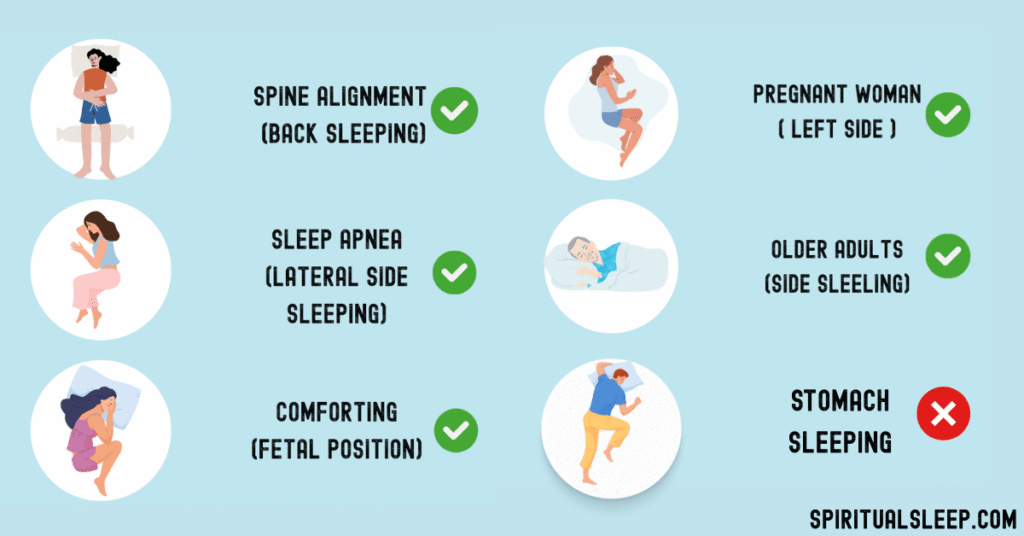Correct Sleeping Position for Adults? A Comprehensive Guide
Sleep is essential for physical and mental well-being, yet many adults struggle to find the right sleeping position that supports their health. As a medical doctor, I’ve seen how poor sleep posture can lead to chronic pain, fatigue, and even sleep disorders.
In this article, we’ll explore “what is the correct sleeping position in adults”, the pros and cons of different positions, and actionable tips to optimize your sleep posture for better rest.
Table of Contents
Why Sleep Position Matters
Your sleeping positionplays a critical role in determining the quality of your sleep and its impact on your overall health. While most people don’t think twice about how they sleep, poor posture during sleep can lead to:
– Chronic Pain: Misalignment of the spine during sleep can cause neck, back, or shoulder pain.
– Sleep Disorders: Certain positions worsen conditions like snoring or obstructive sleep apnea.
– Fatigue: Poor posture can prevent deep, restorative sleep, leaving you feeling tired even after a full night’s rest.
The Impact of Poor Sleep Quality
When you don’t get enough quality sleep due to poor posture or discomfort, it can affect your health in multiple ways:
– Physical Health: Increased risk of heart disease, diabetes, and weakened immunity.
– Mental Health: Poor sleep contributes to anxiety, depression, and mood swings.
– Productivity: Lack of energy and focus during the day impacts work performance and daily activities.
Why Are People Confused About Sleep Positions?
There’s a lot of conflicting advice about which sleeping position is best. Many adults stick to their preferred position without realizing how it might affect their health over time. Common misconceptions include:
1. All Positions Are Equal: Some believe that any position is fine as long as they’re comfortable. However, certain positions can lead to long-term issues like joint pain or breathing problems.
2. Stomach Sleeping Is Natural: While some people find it comforting, stomach sleeping often strains the neck and spine.
3. Back Sleeping Is Always Best: Though beneficial for spinal alignment, back sleeping isn’t ideal for everyone, particularly those with snoring or sleep apnea.

Understanding the Correct Sleeping Position for Adults
The correct sleeping position depends on individual factors like physical health, comfort preferences, and any existing medical conditions. Let’s break down the most common sleeping positions:
1. Back Sleeping (Supine Position)
Lying flat on your back with arms at your sides or resting on your chest.
Benefits:
– Spinal Alignment: Back sleeping allows the head, neck, and spine to rest in a neutral position.
– Reduced Acid Reflux: Elevating the head slightly with a pillow can prevent stomach acid from flowing into the esophagus.
– Minimized Wrinkles: Unlike side or stomach sleeping, back sleeping avoids facial compression against pillows.
Drawbacks:
– Snoring and Sleep Apnea: This position can worsen snoring or obstructive sleep apnea by allowing the tongue to fall back into the throat.
– Lower Back Pain: Without proper support under the lower back or knees, this position may strain the lumbar spine.
Tips for Optimizing Back Sleeping:
1. Use a supportive pillow under your knees to maintain the natural curve of your spine.
2. Choose a medium-firm mattress that prevents sagging while supporting your body weight evenly.
3. If you snore or have mild sleep apnea, consider using an adjustable bed or wedge pillow to elevate your upper body slightly.
2. Side Sleeping (Lateral Position)
Lying on one side with legs straight or slightly bent.
Benefits:
– Improved Breathing: Side sleeping keeps airways open and reduces snoring, making it ideal for people with sleep apnea.
– Digestive Health: Sleeping on the left side improves digestion by preventing acid reflux and promoting better waste elimination.
– Pregnancy-Friendly: Pregnant women are often advised to sleep on their left side to improve circulation for both mother and baby.
Drawbacks:
– Shoulder Pain: Prolonged pressure on one shoulder can cause discomfort or stiffness.
– Facial Wrinkles: Continuous pressure on one side of the face may contribute to wrinkles over time.
Tips for Optimizing Side Sleeping:
1. Use a firm pillow that keeps your head aligned with your spine.
2. Place a pillow between your knees to reduce pressure on your hips and lower back.
3. Alternate sides periodically to avoid uneven pressure on joints or muscles.
3. Fetal Position
Curling up on one side with knees drawn toward the chest.
Benefits:
– Comforting for Many People: This position provides a sense of security and warmth.
– Reduces Snoring: Like side sleeping, it helps keep airways open for better breathing.
Drawbacks:
– Restricted Breathing: Curling too tightly can compress the diaphragm and restrict deep breathing.
– Joint Pain Over Time: Staying in this position for long periods may strain joints or muscles.
Tips for Optimizing Fetal Position:
1. Avoid curling too tightly, keep your body relaxed and slightly extended.
2. Use a supportive pillow under your head and between your knees for added comfort.
3. If you experience joint pain, consider switching to a more neutral side-sleeping posture.
4. Stomach Sleeping (Prone Position)
Lying flat on your stomach with arms either at your sides or under your pillow.
Benefits:
– Reduced Snoring in Some Cases: This position may help reduce snoring by keeping airways open.
Drawbacks:
– Neck Strain:Turning your head to one side puts strain on the neck muscles and spine.
– Spinal Misalignment: Stomach sleeping flattens the natural curve of the spine, leading to discomfort over time.
– Pressure on Internal Organs: This position increases pressure on internal organs like lungs and stomach.
Tips for Optimizing Stomach Sleeping:
1. Use a thin pillow or no pillow at all, to minimize neck strain.
2. Place a small pillow under your pelvis to reduce pressure on your lower back.
3. Gradually transition to side sleeping if you experience chronic pain from stomach sleeping.
My Experience as a Medical Doctor
In my practice as a physician specializing in musculoskeletal health, I often see patients who complain about chronic neck or back pain caused by poor sleep posture. One patient, a 35-year-old man, came to me with persistent lower back pain despite having no history of injury.
After discussing his lifestyle habits, I discovered he was primarily a stomach sleeper using a thick pillow that strained his neck and spine every night. I recommended transitioning to side sleeping with proper pillow support between his knees and under his head. Within weeks, he reported significant improvements in both his pain levels and overall energy during the day.
This case highlights how small adjustments in sleep posture can lead to dramatic improvements in quality of life.
Tips for Optimizing Your Sleep Posture
To ensure restful nights regardless of your preferred sleeping position:
1. Invest in Proper Bedding
– Choose a mattress that suits your body type and preferred sleeping position:
– Side sleepers benefit from softer mattresses that cushion pressure points like shoulders and hips.
– Back sleepers need medium-firm mattresses that support spinal alignment.
– Stomach sleepers should opt for firmer mattresses that prevent excessive sinking.
– Use pillows designed for specific positions (e.g., contour pillows for back sleepers).
2. Practice Good Sleep Hygiene
Adopt habits that promote better sleep quality:
– Stick to a consistent bedtime schedule, even on weekends.
– Avoid caffeine or heavy meals close to bedtime.
– Create a relaxing bedtime routine (e.g., reading or meditating).
3. Adjust Gradually
If you want to change your sleeping position due to discomfort or health reasons:
– Start by using supportive pillows that encourage proper alignment in your new position.
– Practice during naps before committing overnight changes.
Additional Considerations Based on Health Conditions
For Pregnant Women
Pregnant women are advised to sleep on their left side as it improves blood flow to vital organs while reducing pressure on veins like the inferior vena cava.
For Older Adults
Aging reduces flexibility; older adults often find side-sleeping more comfortable but should ensure proper joint support through pillows.
For Those With Sleep Disorders
People with conditions like insomnia or restless leg syndrome may benefit from experimenting with different positions while addressing underlying causes through therapy or medical intervention.
Medical Disclaimer:This article is based on thorough research, scientific studies, and my personal experience as a medical doctor interested in sleep health. This content is for informational purposes only and should not be considered medical advice. Each individual’s sleep needs and health conditions are unique. I recommend consulting with a healthcare professional or sleep specialist to address specific concerns for better sleep.
Conclusion: Prioritize Your Sleep Position for Better Health
Understanding **what is your correct sleeping position in adults** is essential for achieving restful nights and maintaining overall well-being. Whether you’re a back sleeper seeking spinal alignment or a side sleeper looking for better breathing, small adjustments can make all the difference in improving comfort and health outcomes over time.
If persistent discomfort continues despite adjusting your posture, consult healthcare professionals who can provide personalized guidance tailored specifically for you!
References
1. WebMD – [How Your Sleep Position Affects Your Sleep Quality](https://www.webmd.com/sleep-disorders/best-sleep-positions)
2. Sleep Foundation – [Best Sleeping Positions](https://www.sleepfoundation.org/sleeping-positions)
3. Healthline – [What’s the Best Sleeping Position? It Depends](https://www.healthline.com/health/best-sleeping-position)
4. Johns Hopkins Medicine – [Choosing the Best Sleep Position](https://www.hopkinsmedicine.org/health/wellness-and-prevention/choosing-the-best-sleep-position)
5. National Council on Aging – [The Best Sleeping Positions](https://www.ncoa.org/adviser/sleep/sleeping-positions/)






Click Me – Thanks for addressing this! Not many people talk about it.